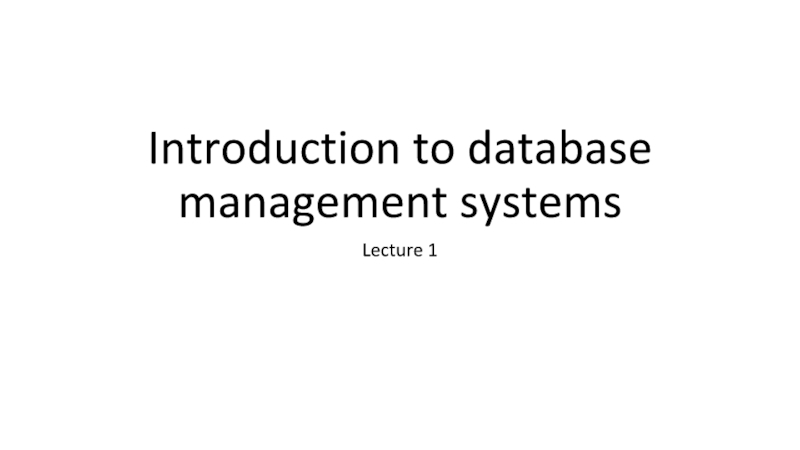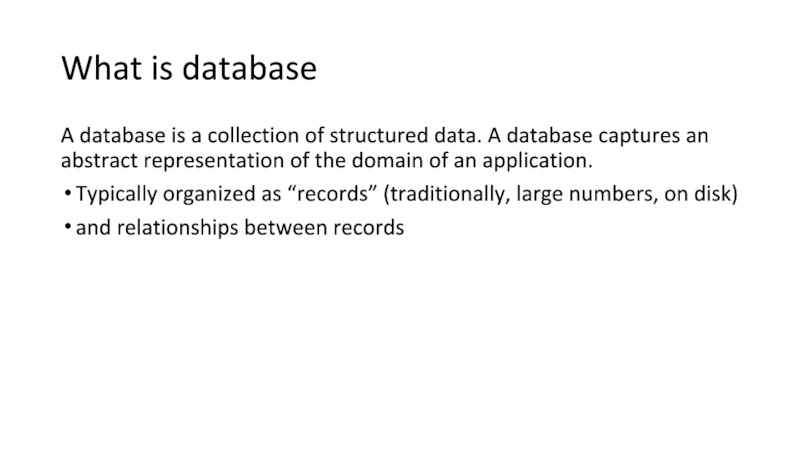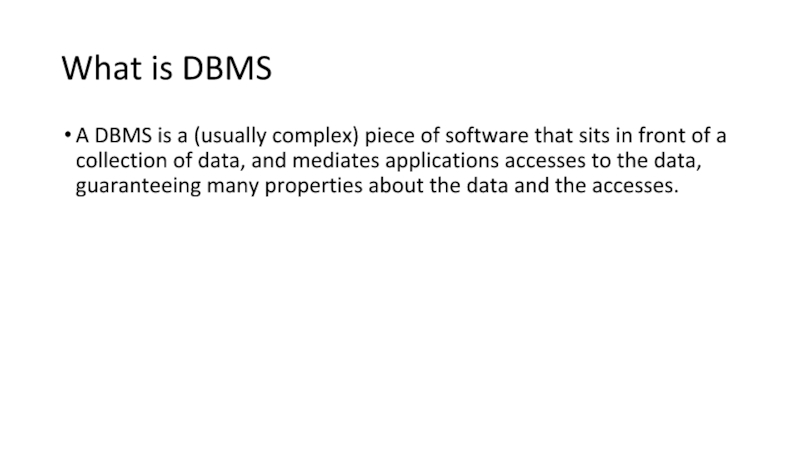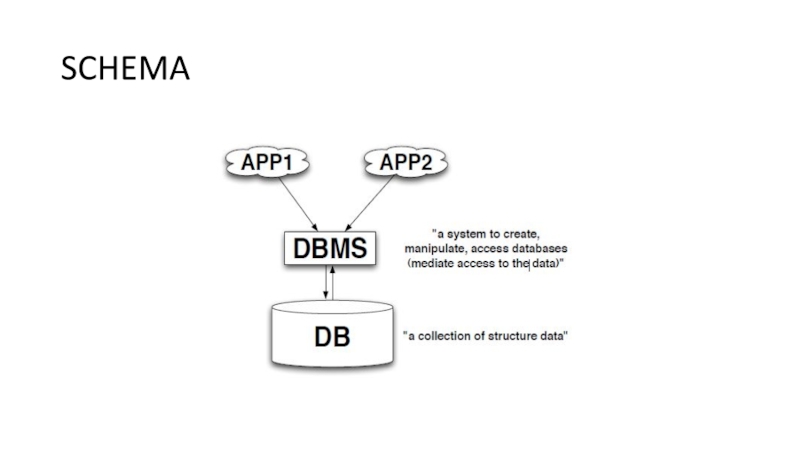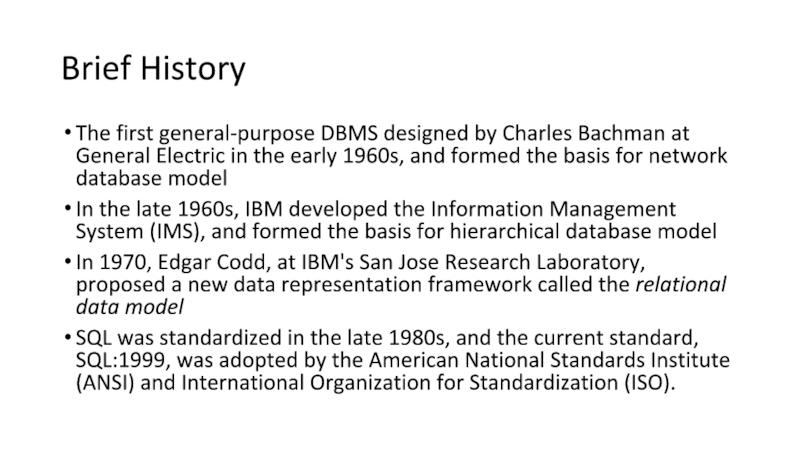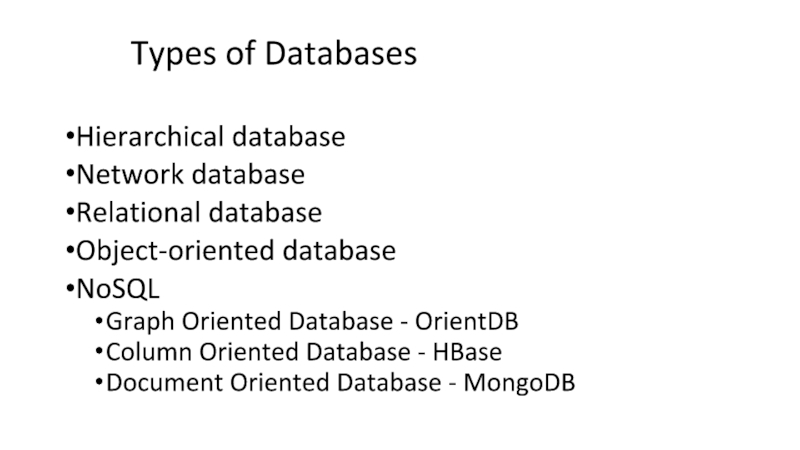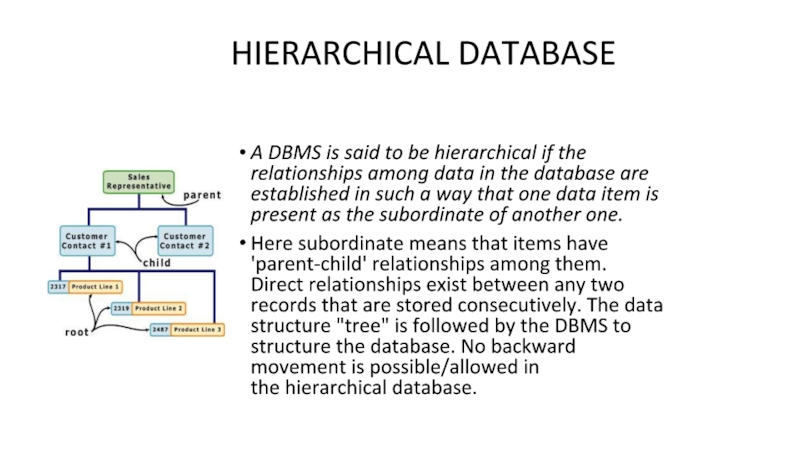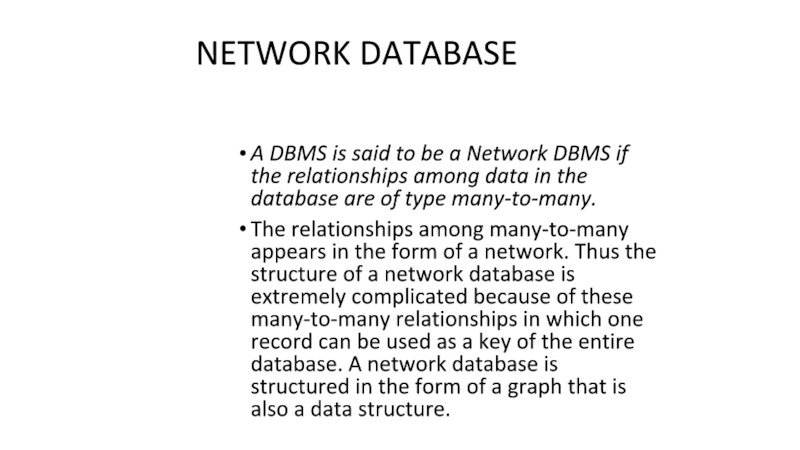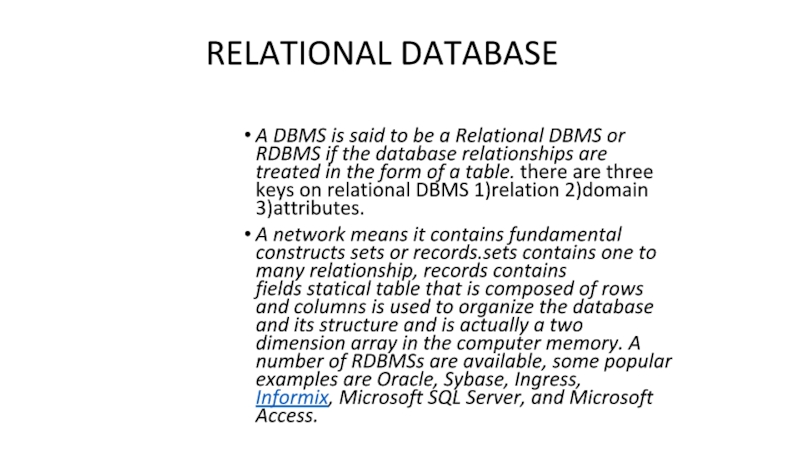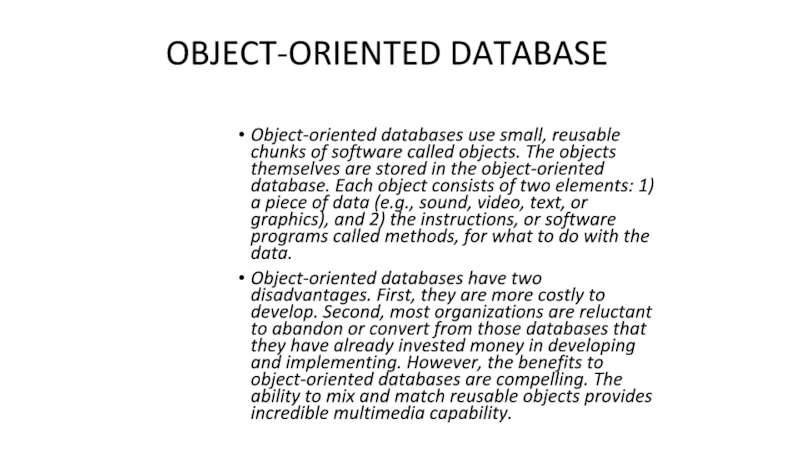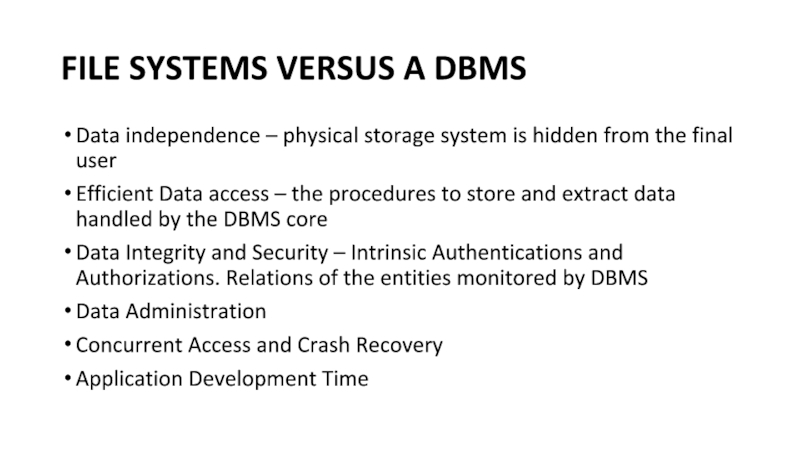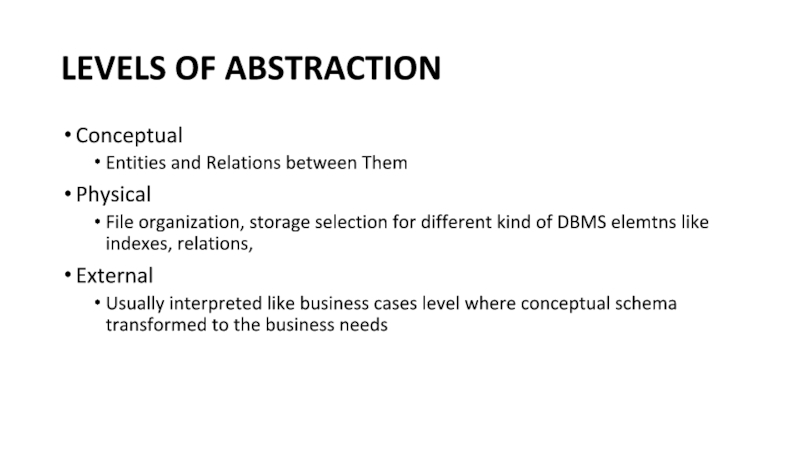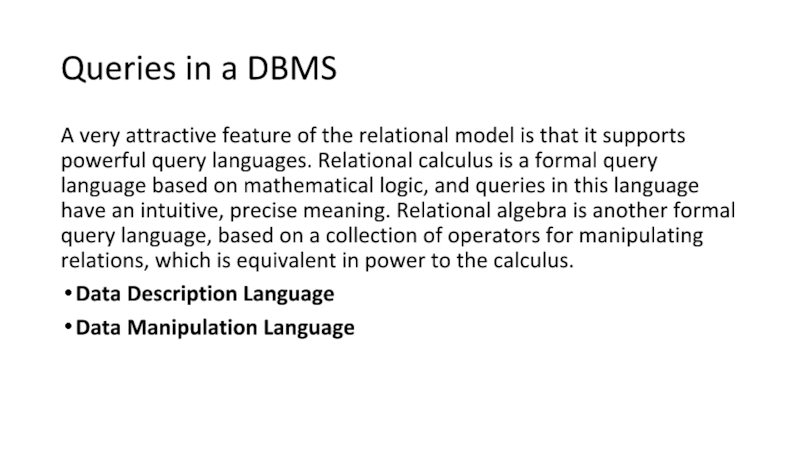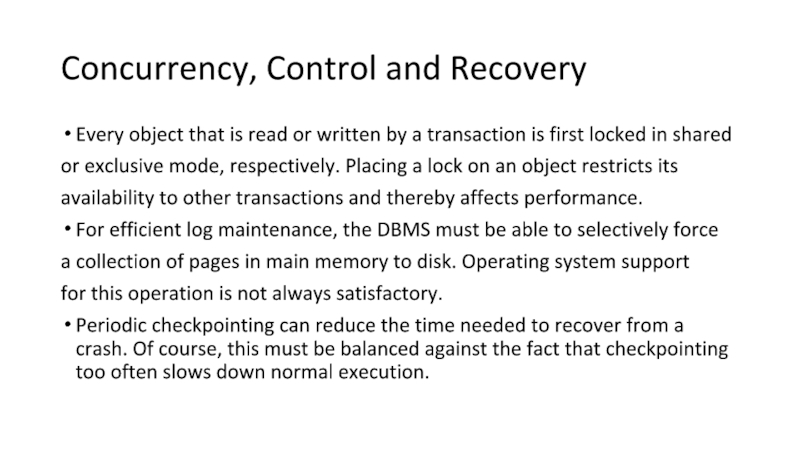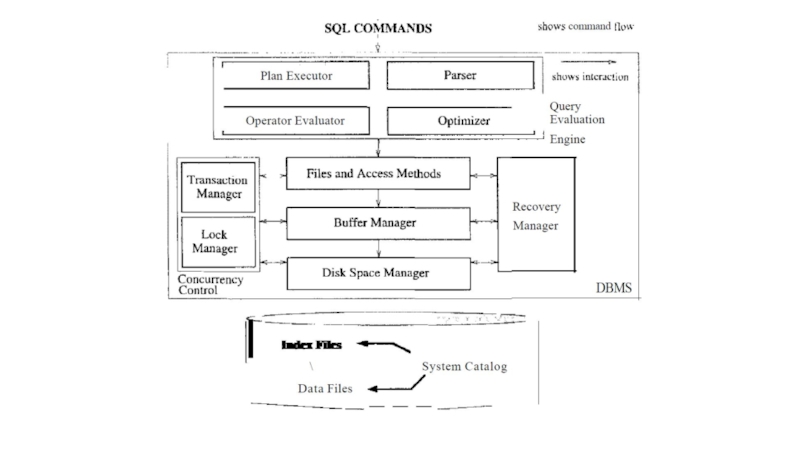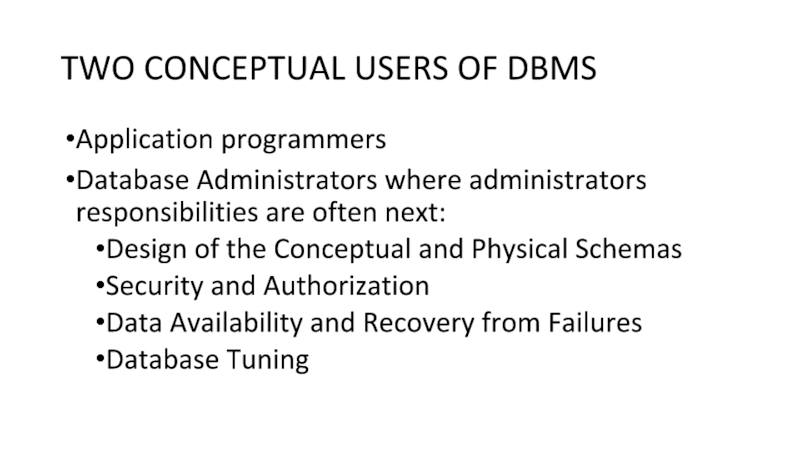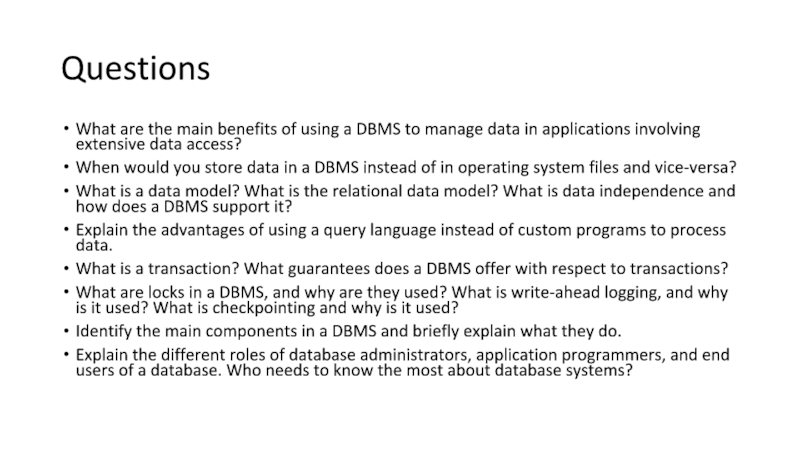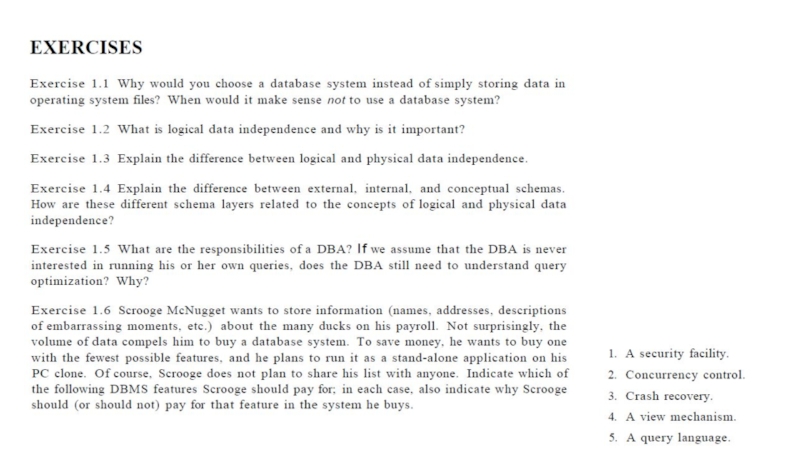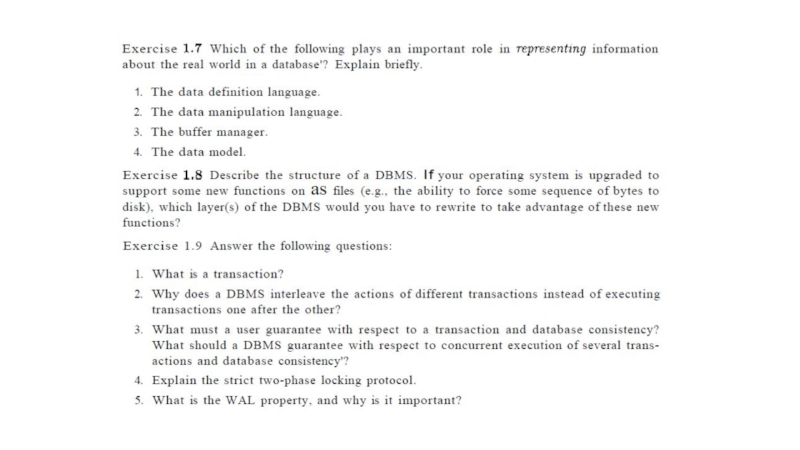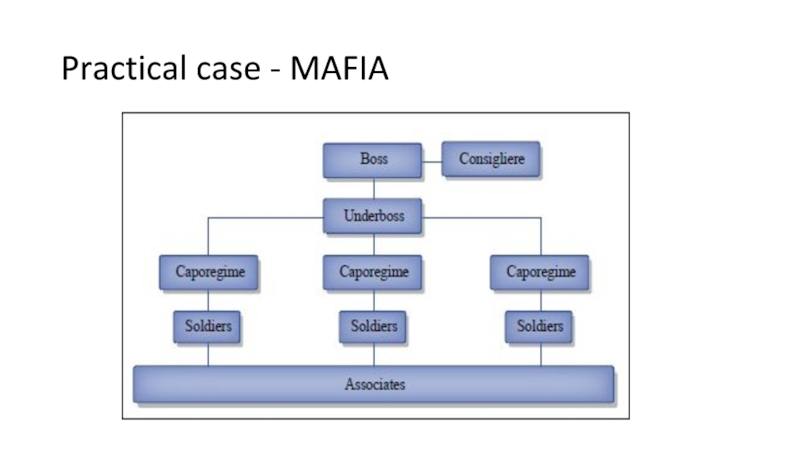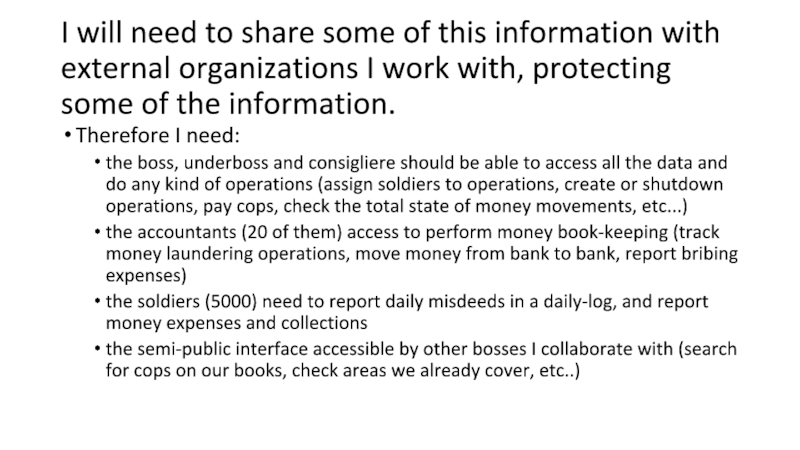- Главная
- Разное
- Дизайн
- Бизнес и предпринимательство
- Аналитика
- Образование
- Развлечения
- Красота и здоровье
- Финансы
- Государство
- Путешествия
- Спорт
- Недвижимость
- Армия
- Графика
- Культурология
- Еда и кулинария
- Лингвистика
- Английский язык
- Астрономия
- Алгебра
- Биология
- География
- Детские презентации
- Информатика
- История
- Литература
- Маркетинг
- Математика
- Медицина
- Менеджмент
- Музыка
- МХК
- Немецкий язык
- ОБЖ
- Обществознание
- Окружающий мир
- Педагогика
- Русский язык
- Технология
- Физика
- Философия
- Химия
- Шаблоны, картинки для презентаций
- Экология
- Экономика
- Юриспруденция
Introduction to database management systems презентация
Содержание
- 1. Introduction to database management systems
- 2. What is database A database is a
- 3. What is DBMS A DBMS is a
- 4. SCHEMA
- 5. Brief History The first general-purpose DBMS designed
- 6. Types of Databases Hierarchical database Network database
- 7. HIERARCHICAL DATABASE A DBMS is said to
- 8. NETWORK DATABASE A DBMS is said to
- 9. RELATIONAL DATABASE A DBMS is said to
- 10. OBJECT-ORIENTED DATABASE Object-oriented databases use small, reusable
- 11. FILE SYSTEMS VERSUS A DBMS Data independence
- 12. LEVELS OF ABSTRACTION Conceptual Entities and Relations
- 13. Queries in a DBMS A very attractive
- 14. TRANSACTION MANAGEMENT Airline reservations when one travel
- 15. Concurrency, Control and Recovery Every object that
- 17. TWO CONCEPTUAL USERS OF DBMS Application programmers
- 18. Questions What are the main benefits of
- 21. Practical case - MAFIA
- 22. I need to store information about people
- 23. I will need to share some of
- 24. What data to store
- 25. What to Consider
- 26. What to represent:, what are the key
- 27. Atomicity: when an accountant moves money from
Слайд 2What is database
A database is a collection of structured data. A
Typically organized as “records” (traditionally, large numbers, on disk)
and relationships between records
Слайд 3What is DBMS
A DBMS is a (usually complex) piece of software
Слайд 5Brief History
The first general-purpose DBMS designed by Charles Bachman at General
In the late 1960s, IBM developed the Information Management System (IMS), and formed the basis for hierarchical database model
In 1970, Edgar Codd, at IBM's San Jose Research Laboratory, proposed a new data representation framework called the relational data model
SQL was standardized in the late 1980s, and the current standard, SQL:1999, was adopted by the American National Standards Institute (ANSI) and International Organization for Standardization (ISO).
Слайд 6Types of Databases
Hierarchical database
Network database
Relational database
Object-oriented database
NoSQL
Graph Oriented Database - OrientDB
Column
Document Oriented Database - MongoDB
Слайд 7HIERARCHICAL DATABASE
A DBMS is said to be hierarchical if the relationships
Here subordinate means that items have 'parent-child' relationships among them. Direct relationships exist between any two records that are stored consecutively. The data structure "tree" is followed by the DBMS to structure the database. No backward movement is possible/allowed in the hierarchical database.
Слайд 8NETWORK DATABASE
A DBMS is said to be a Network DBMS if
The relationships among many-to-many appears in the form of a network. Thus the structure of a network database is extremely complicated because of these many-to-many relationships in which one record can be used as a key of the entire database. A network database is structured in the form of a graph that is also a data structure.
Слайд 9RELATIONAL DATABASE
A DBMS is said to be a Relational DBMS or
A network means it contains fundamental constructs sets or records.sets contains one to many relationship, records contains fields statical table that is composed of rows and columns is used to organize the database and its structure and is actually a two dimension array in the computer memory. A number of RDBMSs are available, some popular examples are Oracle, Sybase, Ingress, Informix, Microsoft SQL Server, and Microsoft Access.
Слайд 10OBJECT-ORIENTED DATABASE
Object-oriented databases use small, reusable chunks of software called objects.
Object-oriented databases have two disadvantages. First, they are more costly to develop. Second, most organizations are reluctant to abandon or convert from those databases that they have already invested money in developing and implementing. However, the benefits to object-oriented databases are compelling. The ability to mix and match reusable objects provides incredible multimedia capability.
Слайд 11FILE SYSTEMS VERSUS A DBMS
Data independence – physical storage system is
Efficient Data access – the procedures to store and extract data handled by the DBMS core
Data Integrity and Security – Intrinsic Authentications and Authorizations. Relations of the entities monitored by DBMS
Data Administration
Concurrent Access and Crash Recovery
Application Development Time
Слайд 12LEVELS OF ABSTRACTION
Conceptual
Entities and Relations between Them
Physical
File organization, storage selection
External
Usually interpreted like business cases level where conceptual schema transformed to the business needs
Слайд 13Queries in a DBMS
A very attractive feature of the relational model
Data Description Language
Data Manipulation Language
Слайд 14TRANSACTION MANAGEMENT
Airline reservations
when one travel agent looks up Flight 100 on
Bank’s database
While one user's application program is computing the total deposits, another application may transfer money from an account that the first application has just 'seen' to an account that has not yet been seen, thereby causing the total to appear larger than it should be.
Слайд 15Concurrency, Control and Recovery
Every object that is read or written by
or exclusive mode, respectively. Placing a lock on an object restricts its
availability to other transactions and thereby affects performance.
For efficient log maintenance, the DBMS must be able to selectively force
a collection of pages in main memory to disk. Operating system support
for this operation is not always satisfactory.
Periodic checkpointing can reduce the time needed to recover from a crash. Of course, this must be balanced against the fact that checkpointing too often slows down normal execution.
Слайд 17TWO CONCEPTUAL USERS OF DBMS
Application programmers
Database Administrators where administrators responsibilities are
Design of the Conceptual and Physical Schemas
Security and Authorization
Data Availability and Recovery from Failures
Database Tuning
Слайд 18Questions
What are the main benefits of using a DBMS to manage
When would you store data in a DBMS instead of in operating system files and vice-versa?
What is a data model? What is the relational data model? What is data independence and how does a DBMS support it?
Explain the advantages of using a query language instead of custom programs to process data.
What is a transaction? What guarantees does a DBMS offer with respect to transactions?
What are locks in a DBMS, and why are they used? What is write-ahead logging, and why is it used? What is checkpointing and why is it used?
Identify the main components in a DBMS and briefly explain what they do.
Explain the different roles of database administrators, application programmers, and end users of a database. Who needs to know the most about database systems?
Слайд 22I need to store information about
people that work for me (soldiers,
organizations I do business with (police, ’Ndrangheta, politicians)
completed and open operations:
protection rackets
arms trafficking
drug trafficking
loan sharking
control of contracting/politics
I need to avoid that any of my man is involved in burglary, mugging, kidnapping (too much police attention)
cover-up operations/businesses
money laundry and funds tracking
assignment of soldiers to operations
etc...
Слайд 23I will need to share some of this information with external
Therefore I need:
the boss, underboss and consigliere should be able to access all the data and do any kind of operations (assign soldiers to operations, create or shutdown operations, pay cops, check the total state of money movements, etc...)
the accountants (20 of them) access to perform money book-keeping (track money laundering operations, move money from bank to bank, report bribing expenses)
the soldiers (5000) need to report daily misdeeds in a daily-log, and report money expenses and collections
the semi-public interface accessible by other bosses I collaborate with (search for cops on our books, check areas we already cover, etc..)
Слайд 26What to represent:, what are the key entities in the real
How to store data: maybe we can use just files: people.txt, organizations.txt, operations.txt, money.txt, daily-log.txt. Each files contains a textual representation of the information with one item per line.
Control access credentials at low granularity: accountants should know about money movement, but not the names and addresses of our soldiers. Soldiers should know about operations, but not access money information
How to access data: we could write a separate procedural program opening one or more files, scanning through them and reading/writing information in them.
Access patterns and performance: how to find shop we didn’t collected money from for the longest time (and at least 1 month)? scan the huge operation file, sort by time, pick the oldest, measure time? (need to be timely or they will stop paying, and this get the boss mad... you surely don’t want that, and make sure no one is accessing it right now). “Tony Schifezza” is a mole, we need to find all the operations and people he was involved or knew about and shut them down... quick... like REAL quick!!!
Слайд 27Atomicity: when an accountant moves money from one place to another
Consistency: guarantee that the data are always in a valid state (e.g., there are no two operations with the same name)
Isolation: multiple soldiers need to add to daily-log.txt at the same time (risk is that they override each other work, and someone get “fired” because not productive!!)
Durability: in case of a computer crash we need to make sure we don’t lose any data, nor that data get scrambled (e.g., If the system says the payment of a cop went through, we must guarantee that after reboot the operation will be present in the system and completed. The risk is police taking down our operation!)
